|
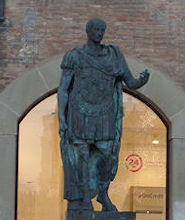 Dwight Peck's personal website Dwight Peck's personal website
San Marino and the Romagna region
Two weeks mostly checking the weather reports hourly
You may not find this terribly rewarding unless you're included here, so this is a good time for casual and random browsers to turn back before they get too caught up in the sweep and majesty of the proceedings and can't let go.
Back to Rimini, for the art, etc.
We had a pleasant walk round Rimini a few days ago, but not unexpectedly the Museo della Città, the city's collection of pictures, decorative arts, and archaeological finds, was closed up tight. So we're heading back for another go at it (19 December 2017).
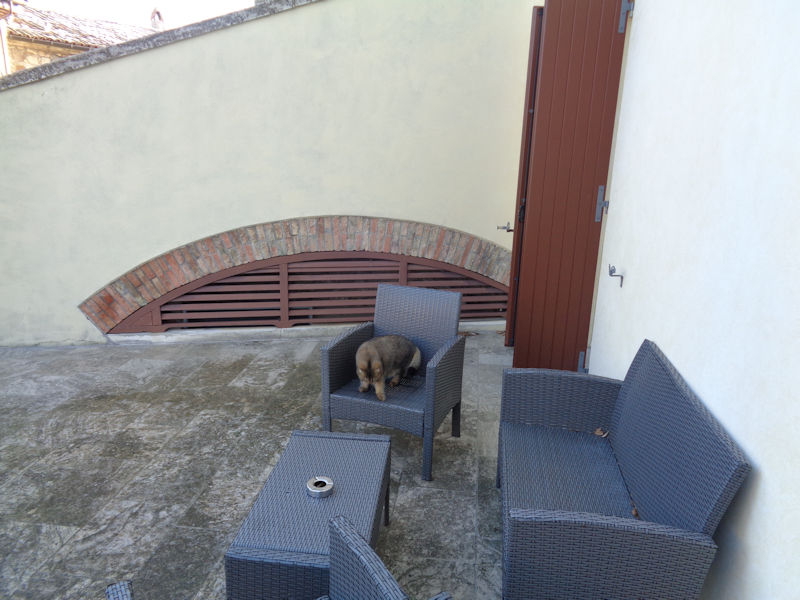
Melvin the Doge trying to get comfortable on our terrace at about 0°C

That, in Melvin talk, is called 'hiding' -- he knows we're going out and doesn't want to be locked up inside again.

Yearning to be back on the terrasse before we've even left
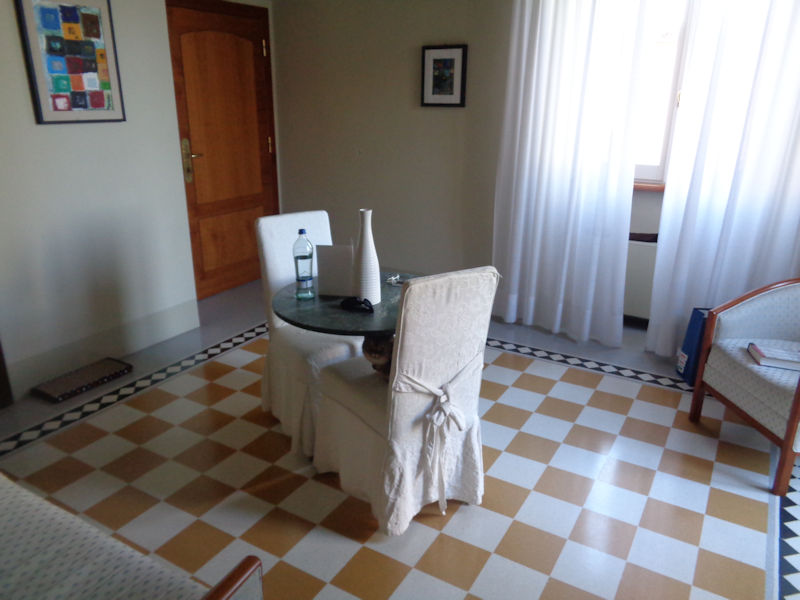
Cleverly hiding again

Goodbye to Montegiardino for a few hours
Downtown Rimini
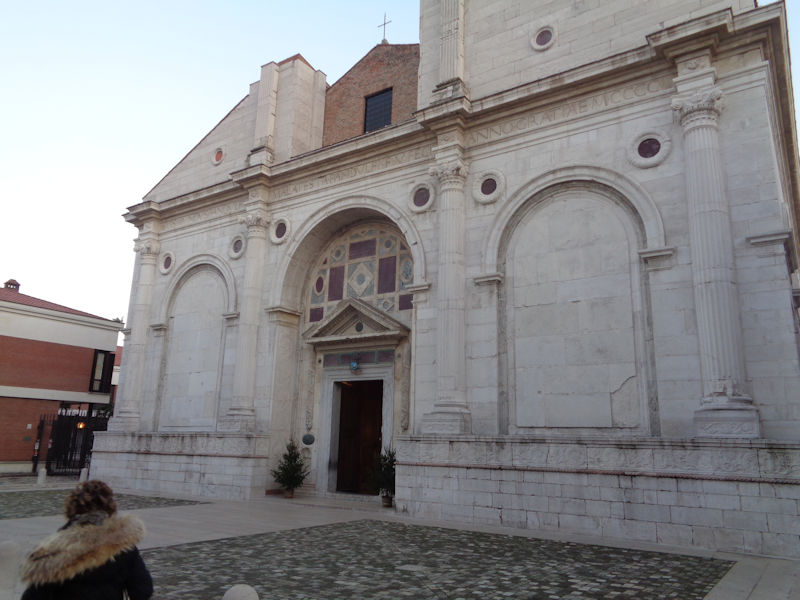
Back to the Tempio Malatestiano, Leon Battista Alberti's redesign for Sigismondo Malatesta in 1450 of the existing 13th century Gothic church. In the original plan, the two blind arcades were meant to hold the sarcophagi of Sigismondo and his longtime mistress and later wife Isotta degli Atti, but alas the money ran out.

A single nave with three apses, and seven chapels along the right side
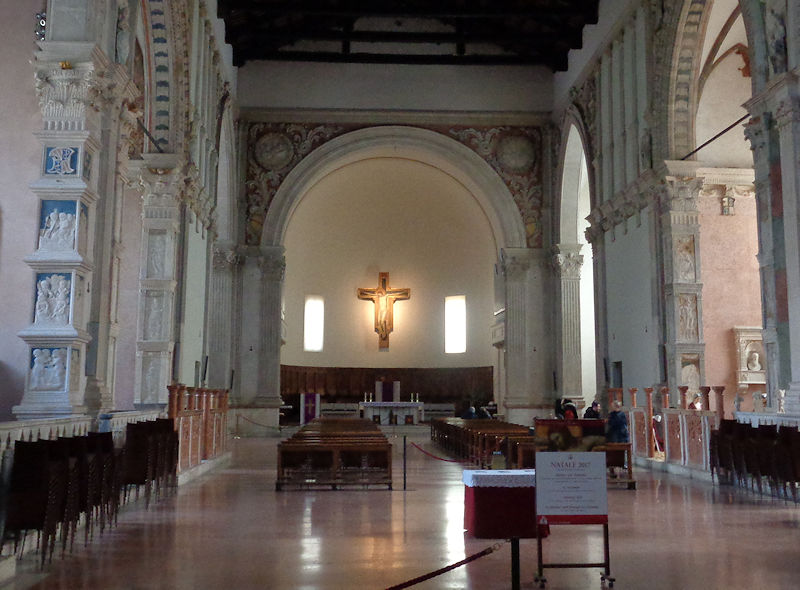
In the centre apse, there is a Crucifixion by Giotto, said to have been made during his time in Rimini in 1308-1312.
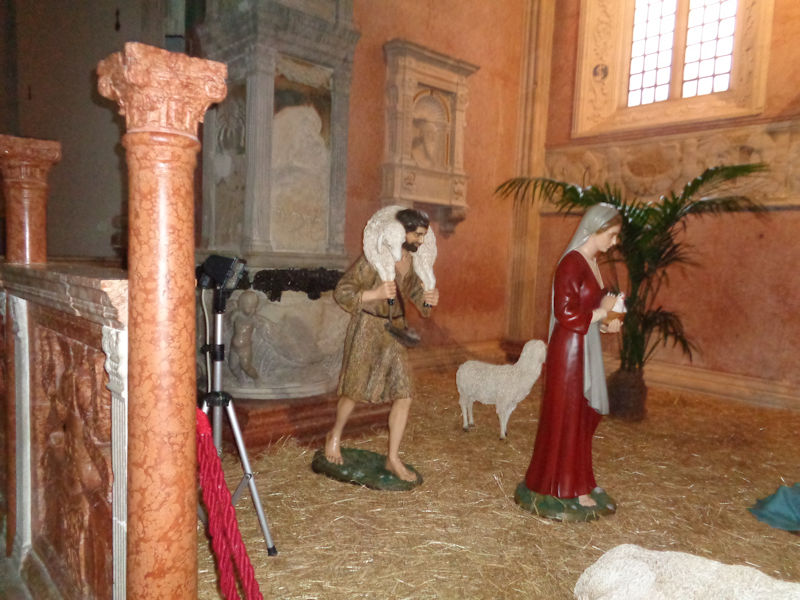
A seasonal crèche in one of the seven chapels along the right side of the interior

One's eye is caught by that thing.
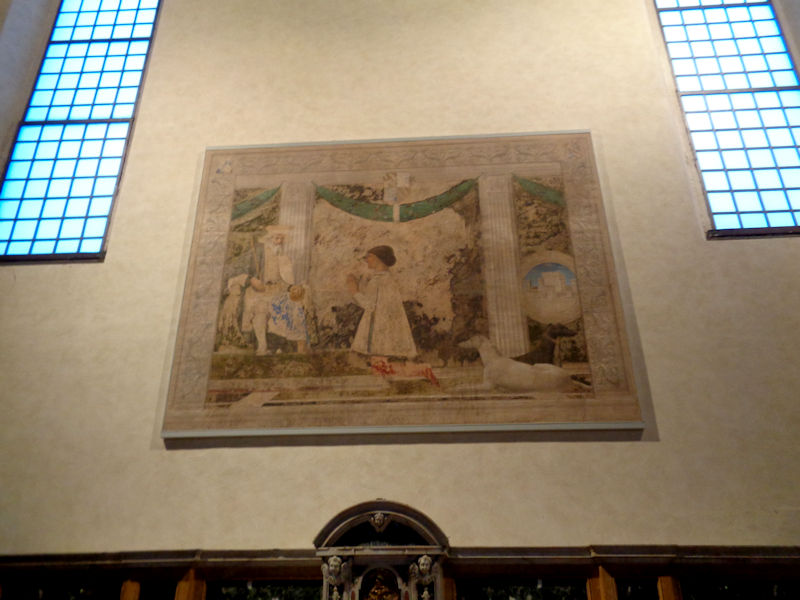
It's Piero della Francesca's 1451 fresco showing Sigismondo praying in front of St Sigismund, patron saint of soldiers, in the saint's own chapel.
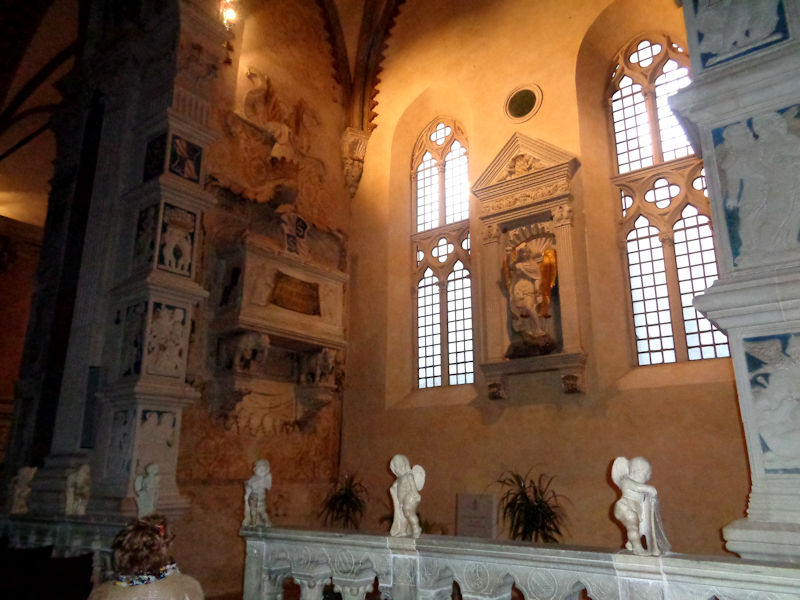
In the next chapel along, the Cappella degli Angeli, that's the tomb of Sigismondo's longtime mistress and eventual wife Isotto.

The common motif: the Malatesta Elephant ('The elephant is not afraid of mosquitos'), Sigismondo's profile, and the intertwined S and I for Sigismondo and Isotta.

There is also a chapel dedicated to the tombs of Sigismondo's first two wives, Ginevra d'Este and Polissena Sforza, another to the planets, another to the 'liberal arts', and one to the bodies of some Malatesta ancestors. Pope Pius II, who hated Sigismondo heartily and wasn't alone in that, thought that the foci on zodiacal signs, his girlfriends, and Sigismondo himself indicated that the church as "full of pagan gods and profane things."

Out to the high street, the intersection of the Via IV Novembre and Via Tempio Malestiano

Reminiscences of Rome in the middle of the high street

The Piazza Tre Martiri, site of the original Roman Forum

The belltower from 1547, restored in 1933. The clock dates from 1562, and the perpetual calendar below it to 1750. The blind arch below houses a memorial to the fatal casualties of World War II.

The retreating German army and the Allied bombers destroyed nearly all of Rimini, and the postwar reconstructions have been enormously successful.

Julius Caesar, deciding whether to cross the Rubicon. It may actually have been here that Caesar explained to his legion his objectives in crossing over towards Rome.

Farther along to the other main square, the Piazza Cavour, with its historic goverment buildings . . .

. . . all tricked up for the Christmas season.

We took small pains to identify these buildings on our last visit and won't take up the time again.


We're actually hurrying through here at the moment, bound for the City Museum, which was closed when we were last here.

The Palazzo Gambalunga, built in 1610-1614, now the Biblioteca Civica Gambalunga, with an enormous collection of manuscripts and 16th century publications, was the first public library in Italy. When Alessandro Gambalunga was dying in 1617 without an heir, he willed the palace and his vast collections to the city and provided for the salary of a librarian.

The Museo della Città is an archaeological museum and picture gallery built into the Jesuit monastery, built from 1746 to 1755, which in turn was added by the Jesuits to their Church of Suffragio, or Chiesa di Saverio, next door (on the right), which was built in 1719-1740. The Jesuit order was not always everywhere welcome, and from 1797 to 1977 the monastery was used as a military and civil hospital before its recreation as the city's museum.

In the 'Corridor of the Last Supper', this huge fresco from the Convent of San Francesco is attributed to Bartolomeo Coda or his dad Benedetto, first half of the 16th century, and is paired with its sinopia drawing for comparison. The City Museum has 40 galleries, including two floors of some 1,500 pictures from the 15th to the 20th centuries and an extensive archaeological section in the basement featuring artifacts from the region as well as complementary materials from the Roman amphitheatre across town and the Domus del Chirurgo, or Surgeon's House, just down the road.

We're always anxious to see what they were eating at the Last Supper -- aside from the bread and wine, of course. As often as not, the main course looks something like a rat or badger, but this one is indistinguishable.

A nice 'Sacra conversazione' by Lattanzio da Rimini, active here around 1500, said to have been a sometime assistant to Giovanni Bellini.

Veronica and her napkin, by Francesco da Cotignola, called Zaganelli, early 16th century, with the transferred image of a remarkably composed Christ

Two kids fighting over a cross; which one will win it? By a 'Pittore romagnolo del XVI secolo'

Maiolica plates, with the story of Jacob at the Well, made by a Rimini master ca. 1574

One can't really even speculate.

Another by Bartolomeo Coda
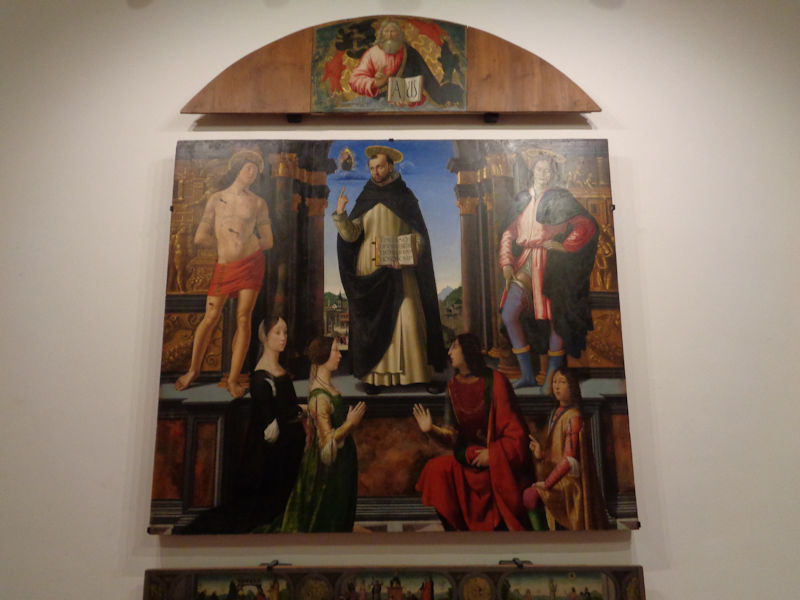
An altarpiece of St Vincent Ferrer, a late 14th century Spanish Dominican said to have been a specialist at converting Jews to Christianity by a variety of means, paired with the inseparable lads St Sebastian and St Rocco showing off his plague buboes on his leg again. The patrons in the foreground are said to be Pandolfo IV Malatesta (known as the 'Bad Pandolfo') with his mother, Elisabetta Aldobrandini, his wife Violante Bentivoglio, and his brother Carlo. By Ghirlandaio and his workshop, about 1494. (The Aldobrandini woman, mistress of Roberto Malatesta, ruled as regent for her son apparently very badly, and the lot of them got swept away by Cesare Borgia's blitzkrieg through the region in 1500.)
 |

|
Two wooden sculptures of the late 15th century, one probably Venetian, the other German

The dead Christ with four angels, by Giovanni Bellini, ca. 1475

The polyptych Crucifixion, dated to about 1400, by Bittino da Faenza (1375-ca.1426), who moved to Rimini from Faenza in 1398.

Scenes from the life of Christ, by the 14th century Giovanni Baronzio, who's considered to be representative of the second generation of the 'School of Rimini' painters who grew up under the influence of Giotto's work in Rimini earlier in the century.

A detail from the Life of Christ, the Last Supper. Which one's missing his halo?

The Coronation of the Virgin with various saints, by Giuliano da Rimini, one of the first generation of the School of Rimini, who may in turn have influenced Giotto.

In the museum's conference room there is the Last Judgment fresco removed from the St Augustine Church, somewhat damaged by Allied bombing runs.

Salome receiving the head of John the Baptist, by Guercino

Guido Reni's 'Joseph and the baby Jesus'

The Last Supper by Mastelletta (Giovanni Andrea Donducci), early 17th century
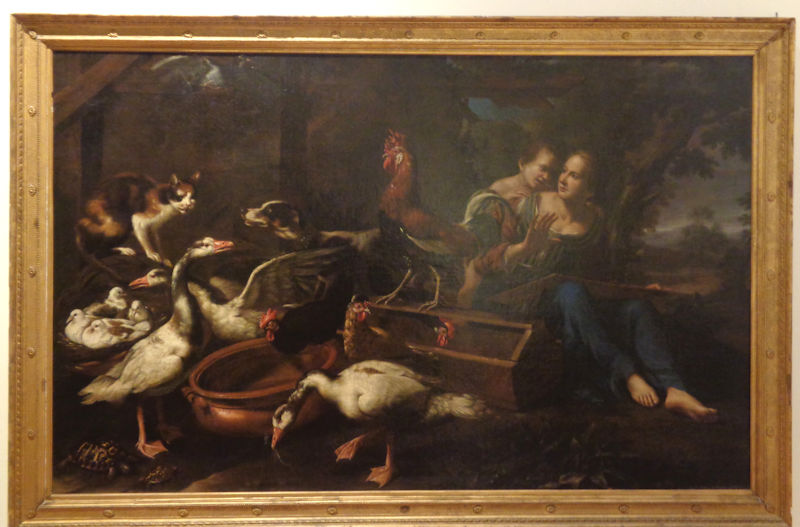
'Farmyard scene' by Jacob van de Kerckhoven (ca.1636-ca.1712), a Flemish painter of still lifes with animals who moved to Venice in his 20s (where he was known as Giacomo da Castello), very successful in his time throughout the Veneto region.

An uninspiring picture inspired by the story of Paolo and Francesca, the lovers murdered by his brother and her husband Giovanni Malatesta, perhaps here in Rimini (though in Gradara they will tell you that it was in Gradara and specify the very room), in about 1285 and cited by Dante in the Inferno. Long a favorite of sentimental artists and writers, this lame 1828 version is by Clemente Albèri of Rimini and Bologna.
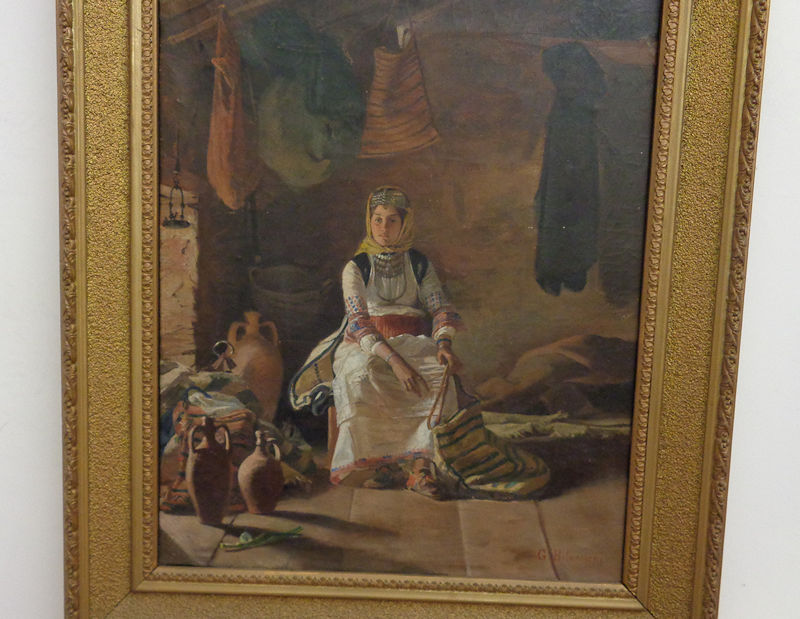
An intriguing picture of a young Greek woman, by Guglielmo Bilancioni (1836-1907) of Rimini

A worthy Pietà by Antonio Crespi (1712-1781), a son of Giuseppe Maria Crespi of the Bolognese School
The archaeological section

Mosaics of ports and ships recall Roman Rimini's maritime importance


Hercules in the centre, it seems

This is a model of the Domus del Chirurgo, or late 2nd century House of the Surgeon, which was discovered in 1989 during works in the Piazza Luigi Ferrari next door to the museum and opened to the public in 2007. The archaeological site is well presented in the Domus itself, but the great mass of Roman artifacts, including a complete set of surgical tools, are here in the City Museum.

A reconstruction of one of the rooms in the House of the Surgeon, whose name, by the way, seems to have been Eutyches, a military doctor judging from the surgical tools associated with removing arrowheads and treating battle wounds.

A reconstruction of the triclinium or dining room
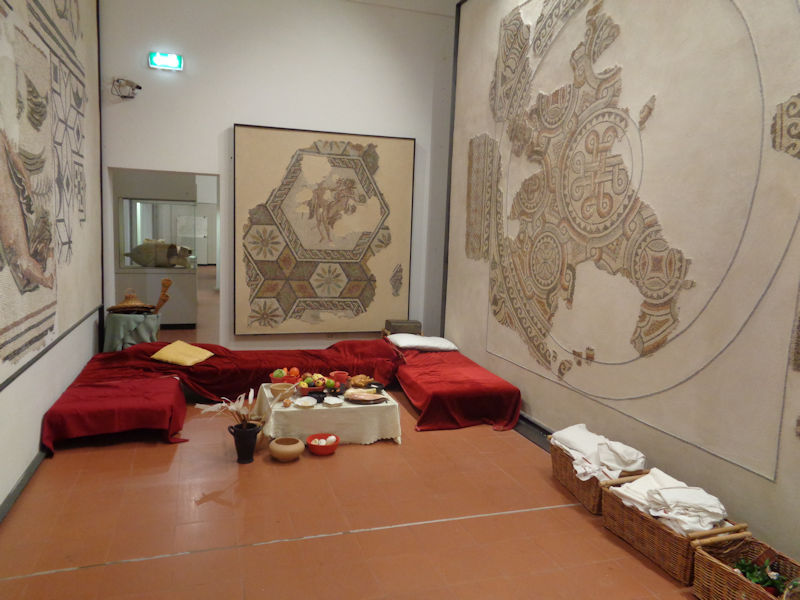

An annotated reproduction of a plan of Rimini in 1617, with the River Marecchia passing under the Tiberius Bridge (red no. 2)

Night is descending upon us.

The Magna Grecia restaurant -- we had a good lunch there the other day.
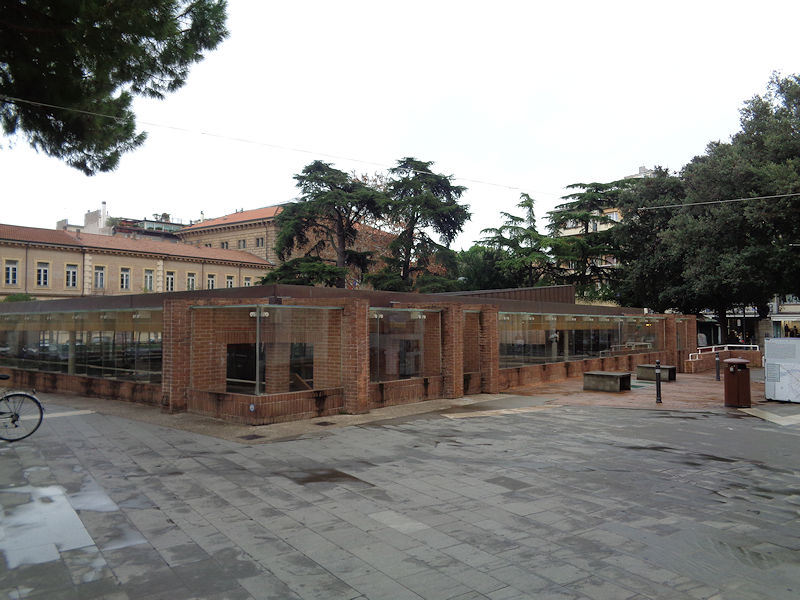
A daytime photo, taken the other day, of the Domus del Chiurgo in the Piazza Ferrari

And now

The expansive remains of the House of the Surgeon


The excavations include, in addition to the Surgeon's House, parts of its residential neighborhood at the northern edge of the Roman city, facing the Adriatic which was at that time a kilometre closer than it is now.

The Surgeon's House, dating from the late 2nd century AD, was destroyed by fire in the mid 3rd century, probably by Germanic raids during the so-called 'Crisis of the Third Century' (AD 235–284).

Time to leave -- back to the carpark near the amphitheatre


Passing the Tempio Malestiano

Along the side of the 15th century Malatesta church, a marble shell built right over its predecessor 13th century Gothic church of San Francesco

The Via Michele Rosa alight

We're looking for a special and much-prized kind of yarn for distant family members.



Next: New digs in Longiano

 Feedback
and suggestions are welcome if positive, resented if negative, Feedback
and suggestions are welcome if positive, resented if negative,  .
All rights reserved, all wrongs avenged. Posted 9 February 2018. .
All rights reserved, all wrongs avenged. Posted 9 February 2018.
|
 Dwight Peck's personal website
Dwight Peck's personal website

























































































